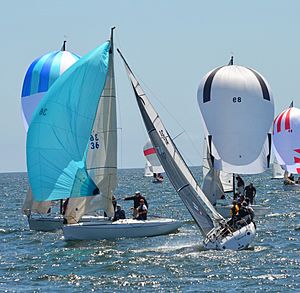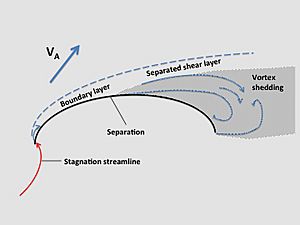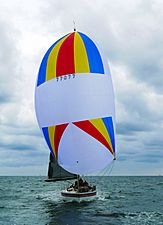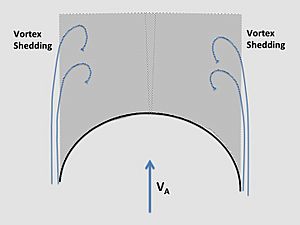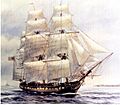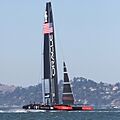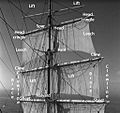Sail facts for kids
A sail is a special fabric or material that uses wind to move boats, ships, and even some land vehicles. Sails are usually made from strong cloth like polyester or other special materials. They often have three or four sides.
Sails help a boat move forward by using the wind. They create two main forces: lift and drag. Lift is like what makes an airplane wing fly, pulling the boat forward. Drag is the force of the wind pushing the sail. The way a sail is angled to the wind, called its angle of attack, changes how much lift and drag it creates.
Sails are usually attached to a tall pole called a mast or a horizontal pole called a boom. A rope called a halyard pulls the sail up. Another rope, called a sheet, controls the sail's angle to the wind. Some sails have stiff strips called battens to help them keep their shape.
Other things that use wind power but aren't traditional sails include wingsails, which are rigid like airplane wings, and kites used on some boats. These are a bit different from the sails we're talking about here.
Contents
Types of Sail Rigs
Sailing boats use two main types of sail setups, called rigs: the square rig and the fore-and-aft rig.
Square Rigs
A square rig has its main sails hanging from horizontal poles called yards. These poles are set straight across the boat, at a 90-degree angle to the boat's body (its keel). A ship with mostly square sails is called a square-rigger. Square rigs work best when the boat is sailing directly downwind.
Fore-and-Aft Rigs
A fore-and-aft rig has sails that are set up along the length of the boat, in line with its keel. Boats with these sails are called fore-and-aft rigged.
Sail History
People have been using sails for thousands of years!
Early Sails and Square Rigs
- Archaeologists have found evidence of sailing boats from around 6000 BCE.
- Ancient Egyptians used sails on their reed boats around 3200 BCE to travel up the Nile River.
- The ancient Sumerians also used square-rigged boats around the same time. They might have traded by sea as far as the Indus Valley.
- Greeks and Phoenicians started trading by ship around 1200 BCE.
Crab Claw Sails
- The first ships that could sail far out into the ocean were built by the Austronesian peoples. They came from what is now Southern China and Taiwan.
- They invented catamarans (boats with two hulls), outriggers (side floats for stability), and special triangular crab claw sails.
- These inventions helped them sail huge distances. This led to the Austronesian Expansion between 3000 and 1500 BC. They explored and settled islands across half the globe, from Southeast Asia to Polynesia and Madagascar.
- Austronesian sails were unique because they often had poles supporting both the top and bottom edges of the sail. Western sails usually only had a pole on the top.
- These sails were often made from strong, salt-resistant woven leaves, like those from pandan plants.
- Later, other sails like the tanja sail and the junk rig developed from the crab claw sail in Southeast Asia. These also kept the feature of having more than one pole supporting the sail.
- The Chinese Song Dynasty started using junk rigs in the 10th century CE. They learned about them from traders from the Srivijayan Empire.
Lateen Sails
- In the Mediterranean Sea, a new type of sail called the lateen sail appeared around the 2nd century CE. It had a single long pole.
- Some believe the lateen sail developed from early contact with Austronesian trading ships that used crab claw sails in the Indian Ocean.
- The fore-and-aft rig, including the lateen, became popular in southern Europe because of the calmer weather. It slowly replaced the square rig.
- Northern Europeans were slower to adopt fore-and-aft rigs. But by the 15th and 16th centuries, these sails became common on rivers and in coastal areas in Britain, France, and the Netherlands. Square rigs remained popular for rougher open seas.
- The lateen sail was especially good for smaller boats sailing against the wind.
- From the 16th to 19th centuries, Europeans developed other fore-and-aft sails like the spritsail, gaff rig, jib, and Bermuda rig. These sails greatly improved how well European ships could sail into the wind.
How Sails Use Wind Power
The forces on a sail depend on the wind's speed and direction, and how fast the boat is moving. The wind you feel on a moving boat is called the apparent wind.
When the front edge of the sail is lined up with the apparent wind, the sail acts like an airfoil (like an airplane wing). This creates lift, which is the main force pushing the boat forward. When the wind is coming from behind the sail, drag becomes the main force.
Boats can often go faster when the sail is creating lift because the airflow around the sail is more efficient. Boats that move through water, like sailboats, usually get their power from lift when sailing at angles from almost directly into the wind to a broad angle away from it. Iceboats, which have very little friction, can use lift even when sailing further downwind because they move so fast, creating a strong apparent wind.
Sailing Downwind with a Spinnaker
Images for kids
-
A Crab claw sail on a wa outrigger ship from the Caroline Islands.
-
A Square rigged frigate.
-
A Sailing hydrofoil catamaran with a wingsail.
-
A Fijian voyaging outrigger boat with a crab claw sail.
-
A traditional Maldivian Baghlah with a fore-and-aft rig lateen rig.
-
A windsurfer.
-
A Formula 16 catamaran.
-
A DN class ice boat.
See also
 In Spanish: Vela (náutica) para niños
In Spanish: Vela (náutica) para niños


